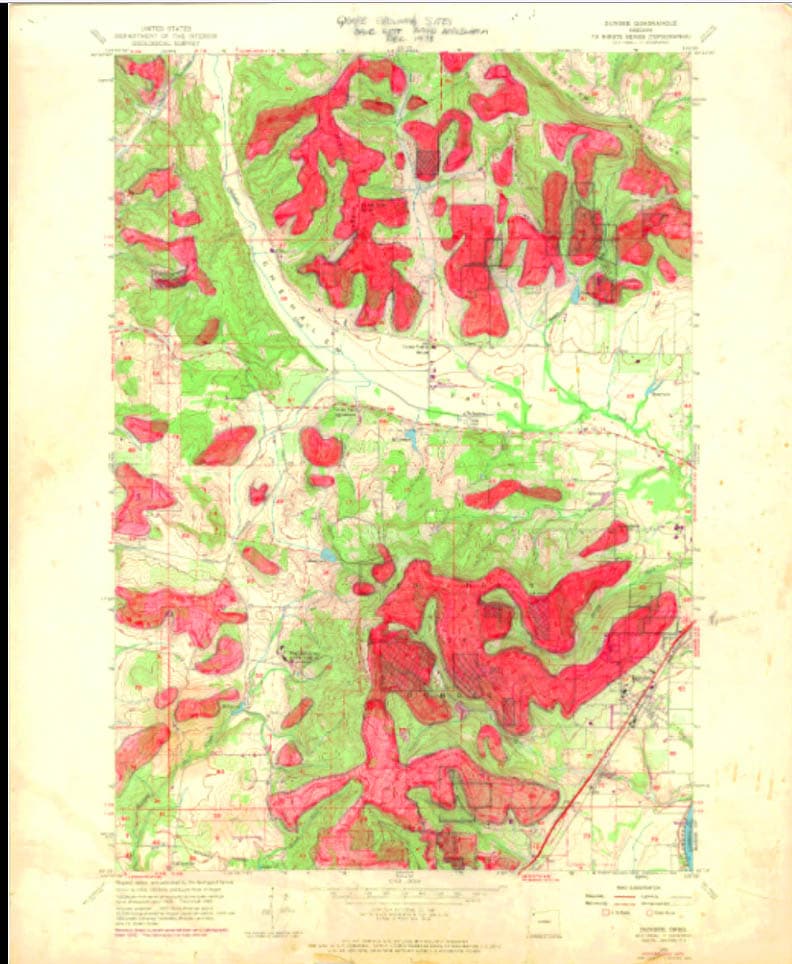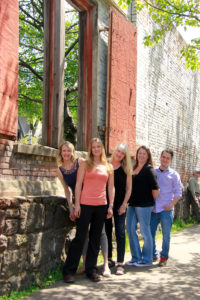Dundee Oregon is in the Willamette Valley, with it’s border actually touching the Willamette River. It is just to the southwest of Newberg, with hills rising to the west and north, giving them the perfect southern exposure they need to grow grapes.
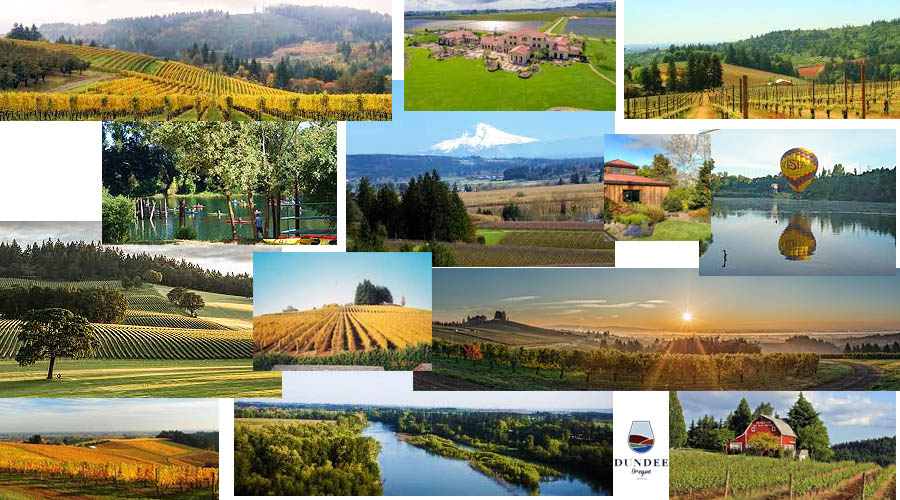
As you drive south along 99W, you can look to your left and see vineyards on the hills that rise up out of the valley. Dundee is the main route for Portlander’s to get to the mid north coast, and when we would go to beaches like Lincoln City, Pacific City or Cape Lookout, it was always a nightmare just trying to get through Dundee. It was always jam packed with cars on a weekend, sometimes taking an hour to get through the whole little corridor. That has all changed because in 2018 they just opened a the Newberg-Dundee bypass that goes right by Dundee, allowing the little town to be a town again! Dundee is such a beautiful area, in the heart of Oregon ‘s wine country, surrounded by gorgeous countryside and hillsides that are covered with vineyards rising up out of the valley’s rolling countryside. It is becoming world famous for it’s excellent wines!Dundee Oregon is approximately 26 miles from Portland.
I always loved Dundee Oregon, we even looked for a house there years ago, but because of the traffic, turning the little town into a big traffic jam with pollution and stress, we decided to move farther east. Now Dundee can flourish, and become maybe what it was meant to be. There are at least 12 wine tasting rooms just in the little town of Dundee Oregon, and many wineries and vineyards all around it. There are also wonderful restaurants and artsy eclectic shops sprinkled among the tasting rooms and restaurants. One of the unique shops I like include Dundee Garden Art which has fountains, pond making supplies, art for the garden and even Koi…a huge selection, some things very unique….everything you need to add an artsy flair to your garden! Briar Rose Creamery has award winning hand crafted cheese, and there is a country market., which is more of a community gathering place, off the main drag with a locally sourced restaurants and local produce…hand crafted breakfasts and wood fired pizzas!
Dundee is also on the Willamette River, so you can enjoy canoeing or kayaking or swimming. A good place to get into the river is the Dundee Paddle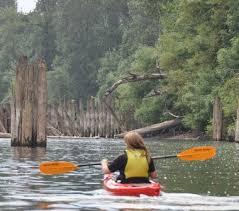 Launch by Chehalem Parks. Access is pretty good, if you want to launch a canoe, you can back down the ramp to just a few feet from the water. There is an island in the river near here, called Ash Island. The channel tends to have logs in the river, so best not to go back there. You can go at least a mile, though, before you enter the main part of the Willamette, with it’s motor boats.
Launch by Chehalem Parks. Access is pretty good, if you want to launch a canoe, you can back down the ramp to just a few feet from the water. There is an island in the river near here, called Ash Island. The channel tends to have logs in the river, so best not to go back there. You can go at least a mile, though, before you enter the main part of the Willamette, with it’s motor boats.
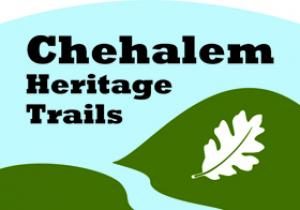 There are also several trails that were designed to let people walk between neighborhoods, cultural sites and parks. The Pinot Noir trail is 2.81 acres and goes east west, connecting east Dundee, several vineyards, Billick Park and Crabtree Park. The Billick Trail, Pacific Dogwood, and Marionberry loop trails are all connecting neighborhoods to schools, and other trails. Each is about 1 mile. The Willamette Trail connects central Newberg to the Willamette River and Dundee Paddle Launch.
There are also several trails that were designed to let people walk between neighborhoods, cultural sites and parks. The Pinot Noir trail is 2.81 acres and goes east west, connecting east Dundee, several vineyards, Billick Park and Crabtree Park. The Billick Trail, Pacific Dogwood, and Marionberry loop trails are all connecting neighborhoods to schools, and other trails. Each is about 1 mile. The Willamette Trail connects central Newberg to the Willamette River and Dundee Paddle Launch.
Dundee Hills is world famous, their website lists over 30 wineries, and 8 vineyards. I write more about the wineries in the Winery sections below.
Wineries in Dundee Area
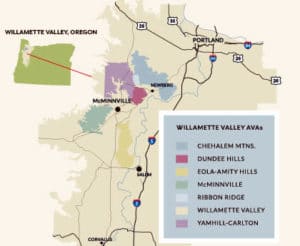 What is special about Willamette Valley and wines? I always wondered, even though I live at the edge of the Willamette Valley and just 10 minutes from the Wine Country! There is an interesting article about it that I found on Willamettewines.com Here is what it says about the area, which is actually divided into 6 different growing areas, each quite different. The wine that grows best here is the Pinot noir. It demands a cool climate to thrive and why small distance differences in the valley often yield wines of distinctively different character. General attributes that make the Willamette Valley suitable for cool climate grape growing include the protection afforded by the Cascade Mountains to the east, Coast Range mountains to the west and a series of lower hill chains to the extreme north of the valley. Almost all grape growing is done on lower hillsides, avoiding deeply fertile alluvial soils and cooler hilltop mesoclimates. And much of this area is in the shadow of the coast range, so gets a little less rain than other areas around Portland.
What is special about Willamette Valley and wines? I always wondered, even though I live at the edge of the Willamette Valley and just 10 minutes from the Wine Country! There is an interesting article about it that I found on Willamettewines.com Here is what it says about the area, which is actually divided into 6 different growing areas, each quite different. The wine that grows best here is the Pinot noir. It demands a cool climate to thrive and why small distance differences in the valley often yield wines of distinctively different character. General attributes that make the Willamette Valley suitable for cool climate grape growing include the protection afforded by the Cascade Mountains to the east, Coast Range mountains to the west and a series of lower hill chains to the extreme north of the valley. Almost all grape growing is done on lower hillsides, avoiding deeply fertile alluvial soils and cooler hilltop mesoclimates. And much of this area is in the shadow of the coast range, so gets a little less rain than other areas around Portland.
The Dundee Oregon area is unique in it’s soil and microclimate, just like the other 5 districts in Oregon. I wrote about each type of area under the town that encompasses it. In the 1970’s, people began to realize that it had a similar soil composition to the Bordeaux region in France. Dundee Hills, which is just outside of Newberg, so only 30 miles SW of Portland. The first grapes in the Willamette Valley were planted in the Dundee Hills, and it is the most densely planted locale in the valley and state. Within the 12,500 acres of this almost exclusively basaltic landmass that runs north-south and overlooks the Willamette River to the south and the Chehalem Valley to the north, more than 1,700 acres of grapes are planted in approximately 50 vineyards.
Here is what their website says about the area:
“Wine, especially Pinot noir wine, is all about place. Plant a pinot vine here and it will taste one way, plant it over there and it will taste a different way. Plant it in the Dundee Hills of Oregon’s Willamette Valley, and it will likely taste of silky red cherries or raspberries with a touch of autumn-dewed forest floor and a smidgen of mysterious minerality. It should be, in short, the very signature of what the world thinks of as Oregon Pinot noir. Oregon Pinot noir did not begin in the Dundee Hills, but it is in the Dundee Hills where Oregon Pinot noir first won its worldwide reputation for greatness.”
– Cole Danehower
Here is a list of wineries in the area
Here is a map giving an idea of where the wineries are. It was taken from Traveldundeeoregon.com. To see interactive map, click here
. 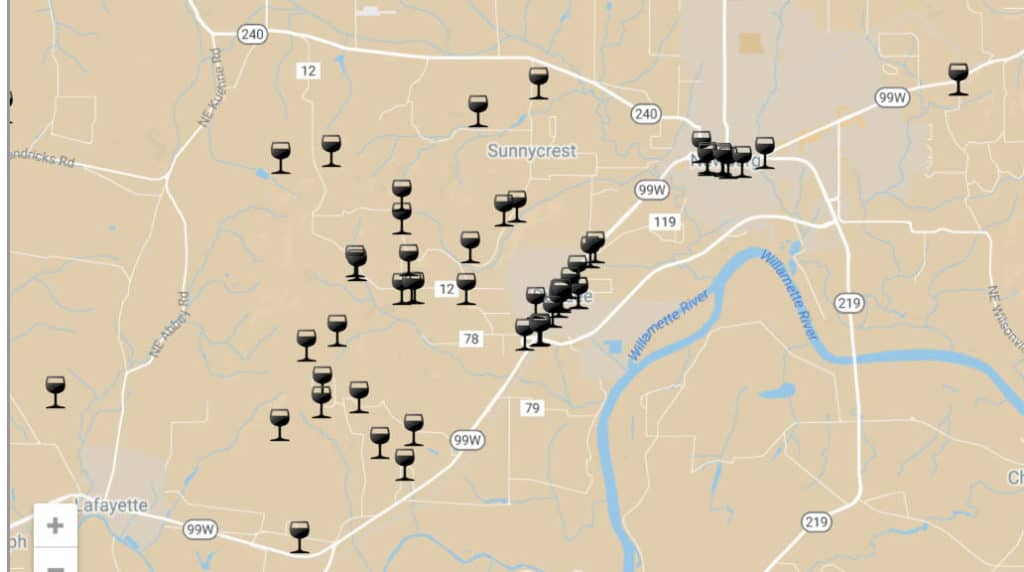
History of Dundee Oregon
William Reid, from Dundee Scotland, came to Oregon in 1874 to establish the Oregon Railway, and kept making more extensions, pushing it farther into the Willamette Valley. The RR was used to transfer grain from the surrounding farms to the steamship, which ran up and down the Willamette River. Dundee was a main junction point for the train because of it’s proximity to the Willamette and they had planned on building a RR bridge across the Willamette to make it more profitable and useful. The little town started to gro, the first post office was established in 1881, but the bridge was never build…so the town became stagnant. Dundee was named for the Scottish town that William Reid came from.
Dundee Oregon was incorporated in 1895, and was mostly a farming community, with rich Willamette Valley soil. They grew all kinds of things, but specialized in prunes, walnuts and hazelnuts. They shipped prunes to Europe before WW1. After the war, they added cherries and other fruit. Then they discovered grapes.
History of the wine making industry in Dundee Oregon began in 1964, when a young graduate of viticulture and enology at UC, David Lett, brought 3000 cuttings from grape plants in California. He found an exposed slope in Dundee, which looked perfect for his vineyard, and he planted them. The rest is history. Several other soon followed, and Dundee Hills became the first of the wineries in Oregon. Soon the area was winning awards on their Burgandies, and the famous Joseph Drouhin purchased 97 acres to construct the first real winery. This area encompasses about 6500 acres. One of the things that makes it so perfect for a vineyard is the ancient lava flow that covered the area from NE Portland all the way out to the Willamette Valley, up to 1000 feet high! This creates the right kind of soil to grow the amazing grapes, and along with the climate, makes this one of the prime vineyard areas in the world!
TheDundee Oregon area was growing fast, and the local wine growers wanted to make sure all this wonderful land was protected. They lobbied Yamhill County to restrict residential growth to areas that were not good for vineyards. They had a relief map to help them figure out which areas to save. The map is below, taken from Museum of the City The red areas are the prime growing areas for vineyards, so they are trying to keep them free of residential areas.
